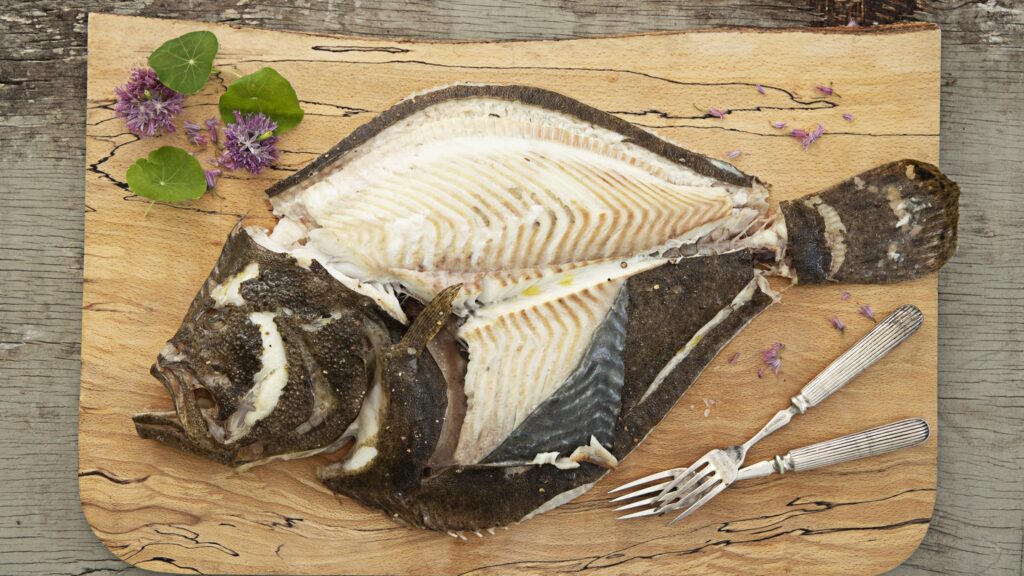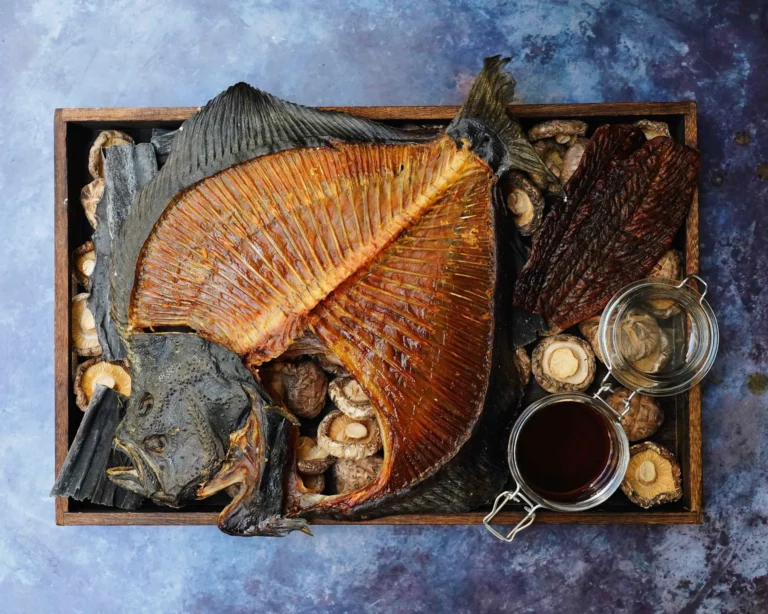Turbot costs a lot because it’s a fancy fish that people love to eat in fancy restaurants. It’s special because it has a delicious taste and a soft texture. But catching Turbot is not easy – it lives deep in the sea, and there aren’t many of them. Because it’s hard to catch, there’s not a lot of Turbot available. Chefs and people who really like good food want Turbot, so the price goes up.
Also, people care about the environment, and how we catch Turbot can affect that. So, when you add up all these things – how much people want it, how hard it is to get, and taking care of the environment – that’s why Turbot is so expensive.
Why is Turbot Celebrated as a Culinary Delicacy?

Turbot is a special treat in the kitchen because it’s not easy to find, making it exclusive and fancy. People love it for its soft texture and rich, buttery taste, making it a top choice for those who enjoy high-quality seafood.
Turbot’s Reputation as a Premium Fish
Exclusivity and Rarity: Turbot is not a fish you find everywhere. Its habitat in deep-sea environments makes it challenging to catch, resulting in a limited supply. This scarcity adds to its allure, making it a premium choice for those seeking something unique and special.
Culinary Prestige: Renowned for its high market value, Turbot is often associated with culinary prestige. Its presence on a restaurant menu can signal a commitment to providing exceptional, top-tier dining experiences.
It’s Unique Flavor and Texture
Delicate and Flaky Texture: Turbot’s flesh is prized for its delicate and flaky texture. When cooked, it tends to break into large, succulent flakes, offering a pleasing mouthfeel that distinguishes it from other fish varieties.
Buttery and Rich Flavor: The flavor profile of Turbot is often likened to butter, with a richness that adds depth to dishes. This unique taste makes it a preferred choice for dishes where the subtleties of the fish shine through without being overpowered by strong flavors.
Versatility in Culinary Creations: Chefs appreciate Turbot’s adaptability in the kitchen. Its mild flavor allows it to harmonize with various ingredients and cooking methods, from grilling and roasting to poaching. This versatility makes it a canvas for culinary creativity, enabling chefs to craft diverse and sophisticated dishes.
Cultural and Historical Significance
Traditional Delicacy: In certain culinary traditions, Turbot holds historical and cultural significance. It may be featured in festive or celebratory meals, symbolizing abundance and prosperity.
Artisanal Appreciation: The meticulous preparation and culinary skill required to handle Turbot contribute to its status as an artisanal ingredient, further enhancing its appeal among chefs and food enthusiasts.
Why Do Various Factors Influence the Pricing of Turbot in the Seafood Market?
Turbot’s price in the seafood market is influenced by many things, like its rare availability and changes in seasons. The challenges of catching it in the deep sea, along with environmental rules, also play a role in deciding how much it costs.
Supply and Demand
How supply and demand dynamics impact Turbot prices
Limited Global Availability: Turbot’s distribution is not widespread, primarily inhabiting deep-sea environments. As a result, the global supply remains limited, and the delicate balance between supply and demand significantly affects its market value.
Exclusivity in Culinary Circles: Turbot’s reputation as a premium fish elevates its demand in culinary circles, particularly among chefs who seek exclusive and high-quality ingredients. This heightened demand plays a pivotal role in shaping Turbot prices.
Seasonal variations
Migration Patterns: Turbot may exhibit seasonal migrations, affecting its availability in specific regions during different times of the year. This migratory behavior introduces seasonal variations in supply, influencing market prices accordingly.
Regulatory Impact: Seasonal fishing restrictions imposed by regulatory bodies to safeguard Turbot populations during critical periods impact the supply chain. Understanding and adapting to these seasonal shifts are vital considerations for pricing dynamics.
Fishing Challenges
Difficulties in Turbot fishing that may contribute to higher costs
Deep-Sea Challenges: Turbot’s habitat in deep-sea environments adds complexity to the fishing process. Specialized vessels and equipment are required, contributing to higher operational costs for fishers targeting Turbot.
Labor-Intensive Techniques: Turbot is often caught using labor-intensive methods, such as longlining or trawling, which demand manual effort and skilled labor. The associated costs with employing these techniques contribute to the overall expense of Turbot fishing.
Environmental or regulatory factors affecting the fishing process
Environmental Sustainability: Concerns about overfishing and ecological sustainability influence the regulatory landscape for Turbot fishing. Compliance with sustainable practices, such as using selective gear or respecting quotas, may require investments in technology and adjustments to fishing practices.
Regulatory Compliance Costs: Sticking to fishing regulations aimed at preserving marine ecosystems can result in additional costs for fishers. This includes obtaining permits, adopting eco-friendly gear, and implementing measures to reduce bycatch, all of which contribute to the overall expense of Turbot fishing.
How Do Different Fishing Methods Influence the Cost of Harvesting Turbot?
Fishing methods play a crucial role in determining the cost of seafood, including Turbot. The choice of fishing technique can influence various aspects of the fishing process, contributing to the overall expenses incurred by fishers.
Labor Intensity: Certain fishing methods, such as longlining or trawling, can be labor-intensive. The manual effort involved in these techniques, from deploying and retrieving gear to processing the catch, requires skilled labor, which contributes to higher labor costs.
Equipment Expenses: Different fishing methods require specific equipment, ranging from specialized boats to gear like longlines or trawl nets. Investing in and maintaining this equipment can be a significant expense for fishers, influencing the overall cost of Turbot fishing.
Fuel Costs: The choice of fishing method can affect fuel consumption. Techniques like trawling may involve towing heavy nets, leading to increased fuel usage. Fluctuations in fuel prices directly impact the operational costs of fishing and, consequently, the cost of the harvested Turbot.
Environmental Impact: Some fishing methods have a greater environmental impact than others. Sustainable and eco-friendly practices often require adjustments in fishing gear and techniques. Adhering to these practices may involve additional expenses but can be essential for long-term ecological preservation.
Regulatory Compliance: Fishing methods are subject to regulations aimed at conserving marine ecosystems and maintaining sustainable fisheries. Compliance with these regulations may necessitate modifications to fishing practices or the adoption of specific gear types, leading to additional costs for fishers.
How Do Global Market Trends Influence Turbot Prices and Consumer Preferences?

Global market trends significantly impact the price and popularity of Turbot fish. With a limited worldwide supply of around 5,000 tonnes per year, high demand often leads to increased prices, making Turbot a pricier option for consumers. The export and import prices of Turbot
Fish also play a role in its overall cost. For example, the export price per kilogram in the US rose from $3.13 in 2016 to $8.08 in 2018, before falling to $3.68 in 2020.
Similarly, the import price in Canada fluctuated, rising from $3.90 in 2017 to $3.88 in 2021 and then dropping to $3.45 in 2022. These price changes directly affect the market price of Turbot.
Consumer preferences are crucial in shaping Turbot’s market dynamics. Research in northern Germany showed a positive response to eco-labeled seafood, with consumers willing to pay more for wild-caught fish over farmed alternatives. Despite frozen fish being a top seller in the German market, consumer attitudes toward it are generally negative.
The unique taste of Turbot, described as subtly sweet and mildly buttery, contributes to its premium pricing. With firm and meaty flesh that holds up well during cooking, Turbot is nicknamed the “King of the Sea.” These qualities, combined with eco-conscious consumer choices and global price fluctuations, make Turbot a distinctive and relatively higher-priced seafood option.
FAQ
How much is turbot per kilo?
The price of turbot per kilo can vary depending on factors such as location, market demand, and seasonality. It is considered a premium fish, often commanding a higher price compared to more common seafood options.
Is turbot a rare fish?
Yes, turbot is considered a relatively rare fish. Its deep-sea habitat, limited availability, and the challenges associated with fishing contribute to its exclusivity in the seafood market.
Is turbot the most expensive fish?
While turbot is expensive, it may not always be the most expensive fish. Other factors such as market conditions, availability, and culinary demand can influence the pricing of different fish species.
What is the most expensive fish to own?
The Arowana fish is often considered one of the most expensive fish to own, with certain rare and ornamental varieties commanding high prices among aquarium enthusiasts and collectors.
How does turbot taste?
Turbot is prized for its delicate, flaky texture and a rich, buttery flavor. Its taste is often described as mild yet distinctive, making it a sought-after choice for culinary enthusiasts.
Which fish is most costly in the world?
The Bluefin Tuna holds the title for one of the most costly fish globally, particularly the prized Bluefin Tuna varieties that can reach high prices at auctions.
What fish is worth $1 billion dollars?
The Tuna, especially the Bluefin Tuna, is known for reaching high prices in the market, with individual fish sometimes fetching substantial amounts, though not necessarily reaching $1 billion.
What is the cheapest fish I can buy?
Common and affordable options include tilapia, catfish, and mackerel, making them some of the cheapest fish available in the market.
What is the most beautiful fish?
The Mandarin Fish is often regarded as one of the most beautiful fish, with its vibrant and intricate coloration making it a prized addition to aquariums.
Final words
All things considered, the high cost of Turbot is a result of a combination of factors. Its exclusivity and demand in high-end restaurants contribute to its premium status. Limited supply, challenges in fishing, and adherence to environmental regulations also play crucial roles.
Culinary preferences, regional market trends, and economic influences further impact Turbot pricing. Ultimately, the delicate texture and rich flavor of Turbot, combined with its scarcity, make it a sought-after culinary delicacy. While its price may be steep, the unique experience it offers to discerning palates reinforces Turbot’s position as a symbol of luxury in the world of seafood.

